The forest of the Western Ghats buzzed with life around me. Working as an environmentalist, I’d spent my days in many green corners of the world, but this place always felt special. It was during one of our campaigns to promote reforestation that I first heard about the Bishnois community. A fellow activist shared tales of their remarkable commitment to nature conservation, which, frankly, seemed too extraordinary to be true for such a modest community. How had this small group in the arid landscapes of Rajasthan achieved such feats when large organizations struggled? What drove them to defend the environment with such fervor? Are these just stories, or is a deeper truth waiting for exploration? Despite pioneering the Eco-movement in India, why don’t they receive recognition?
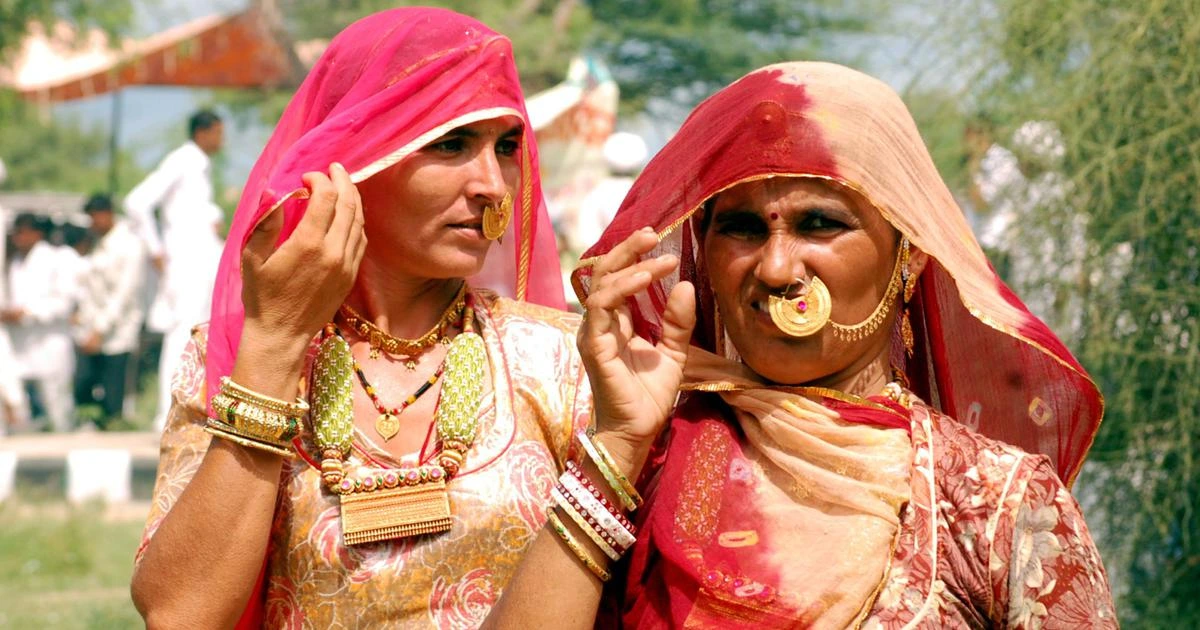
These questions churned within me, kindling a fire of curiosity. I felt a pull towards this community, an urge to understand their ethos and witness their profound bond with the environment firsthand. I realized mere tales or articles wouldn’t suffice; I needed to be there, to seek answers to the myriad questions swirling in my mind. Hoping to draw inspiration from their unwavering dedication, I planned a solo trip to Rajasthan that very evening. I had booked a Savaari cab to explore the Bishnoi villages. The vibrant state had always been on my travel wishlist, but now it beckoned with a deeper purpose – the Bishnoi village.
A flight to remember: Discovering Bishnoi legacies
As my plane soared away from Mumbai’s sprawling cityscape, the thrill of a new journey bubbled within me. This journey wasn’t just another sightseeing adventure; I was heading into the depths of an ancient culture’s embrace. To enrich my understanding, I packed a unique read for the flight: “Cultural Tourism and Bishnois of Rajasthan.” A fellow ecology enthusiast had spoken volumes about it, and I was eager to delve into its pages.
I found a detailed section about the geographical placement of the Bishnoi villages. These communities are strategically dotted within the expansive Thar desert. Most of them situated within a radius of approximately 50 kilometers from the historic city of Jodhpur in western Rajasthan. It was one of my dreams to explore Rajasthan on my own, and this blog influenced me a lot. It clearly talks about Rajasthan’s beauty and history. The desert, primarily characterized by its sandy terrains and sparse vegetation,. It contrasts sharply with the lush greenery maintained by the Bishnois. The stark contrast between the desert landscape and the verdant Bishnoi villages wasn’t merely a result of nature’s whim but a legacy carved over centuries. My fingers flipped to the next chapter, “The Birth of an Eco-Revolution: The Bishnoi Saga.” I delved into their history, which promised tales of courage, sacrifice, and an unwavering commitment to Mother Earth.
Desert guardians: The tale of the Bishnois
The origin of the Bishnoi community is deeply intertwined with the teachings and vision of Shree Guru Jambheshwar, affectionately known as Jambhoji. Born in 1451, he laid the philosophical and practical groundwork for the Bishnoi Panth, a distinct way of life centered on harmony with nature. While some have referred to the community using the term “Vishnoi,” hinting at a connection with Lord Vishnu, the majority identify as “Bishnoi .”There’s also a segment that lovingly addresses themselves as “Jambeshwarpanthi” in a nod to their foundational Guru.
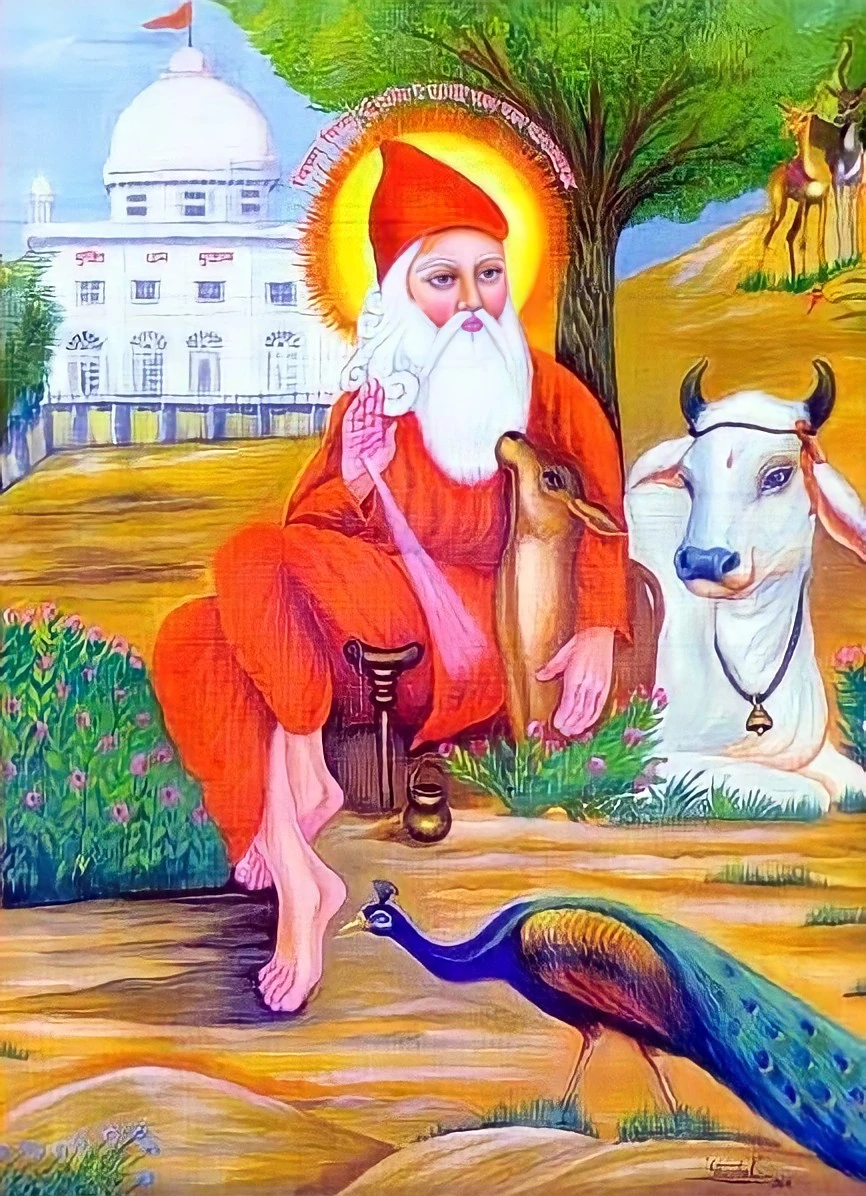
Jambhoji’s teachings are profound, encompassing various aspects of life. He presented a set of 29 tenets, which are documented in the “Shabadwani,” a revered text that consists of 120 verses or shabads. These tenets touch upon personal well-being, with guidelines for maintaining hygiene and health.
But his teachings stand out with the unwavering emphasis on environmental consciousness. Jambhoji advocated against killing animals and the felling of green trees, urging his followers to protect all forms of life. He also emphasized using firewood that is free from small insects, showing a deep respect for even the tiniest creatures. Interestingly, he also advised against wearing blue clothing, a directive rooted in environmental concerns. As the traditional dye for this color was sourced by cutting numerous shrubs. Due to this deep-rooted respect for nature and proactive efforts to preserve the environment, the Bishnois have been fittingly dubbed the world’s first eco-warriors.
Twelve pivotal principles: A drive into Bishnoi wisdom
Upon landing at the Jodhpur airport, the city’s aura immediately enveloped me. Jodhpur is also known as the ‘blue city’ of India. ‘The blue city’ always amazed me, so before starting the journey to Bishnoi village, I planned to explore Jodhpur as well. I started to research things to do in Jodhpur. I headed straight to a hotel, eager to freshen up before embarking on the journey. My driver, a Jodhpur local with a warm smile and a pleasant demeanor, greeted me. As we began our drive, the vast expanse of the Thar Desert unfurled outside my window.
Breaking the comfortable silence, he inquired, “What brings you to this part of our state?”
“I’m keen to understand the Bishnoi community’s unique bond with nature,” I replied. “I’ve read and heard much, but experiencing it firsthand is different.” He nodded a proud glint in his eyes. “Ah, the Bishnois! Our eco-warriors. Do you know about the principles they follow?” “I’ve come across them briefly,” I admitted, “but I’d love to hear it from someone who’s lived amidst it.”He cleared his throat, preparing to impart some age-old wisdom.
The Bishnois Principles
“The Bishnois follow 29 guiding principles set by Guru Jambhoji. While I can’t delve into each one due to our short journey, let me highlight the essence.” He continued, “They believe in maintaining personal and environmental purity. This means daily baths, prayers, and filtering everything—from water to firewood—to ensure no harm to tiny creatures. Honesty is deeply valued, so lying, stealing, or even harboring negative thoughts are discouraged. Fasting on specific days, worshiping Lord Vishnu, and practicing mercy towards all beings is pivotal.” Pausing for breath, he added, “A significant part of their ethos is environmental conservation. Cutting green trees is prohibited. They’re strictly vegetarian, don’t consume intoxicants like alcohol or tobacco, and even the color of their clothes is chosen to keep nature in mind. For instance, they avoid blue because its traditional dye harms many shrubs.”
I listened intently, absorbing his words, realizing that Bishnoi’s principles weren’t just rules—they were a way of life, a harmonious blend of personal discipline, and profound respect for the environment.
Bishnoi Village: A Journey Through Age-Old Traditions
Navigating the sandy trails, a world far removed from urban chaos began to reveal itself. Dotting the horizon were uniquely shaped, round huts, standing as symbols of a life steeped in tradition. The rolling dunes were occasionally interrupted by herds of graceful black bucks and camels, painting a scene that seemed straight out of folklore.
Bishnoi Village was my destination, and as I ventured deeper, I was increasingly drawn to its charm. The architectural flair of the rounded huts, the expansive agricultural lands stretching out like a green carpet, and the village women adorned in vibrant costumes—every sight offered a striking contrast to the often-romanticized regal aura of Rajasthan.
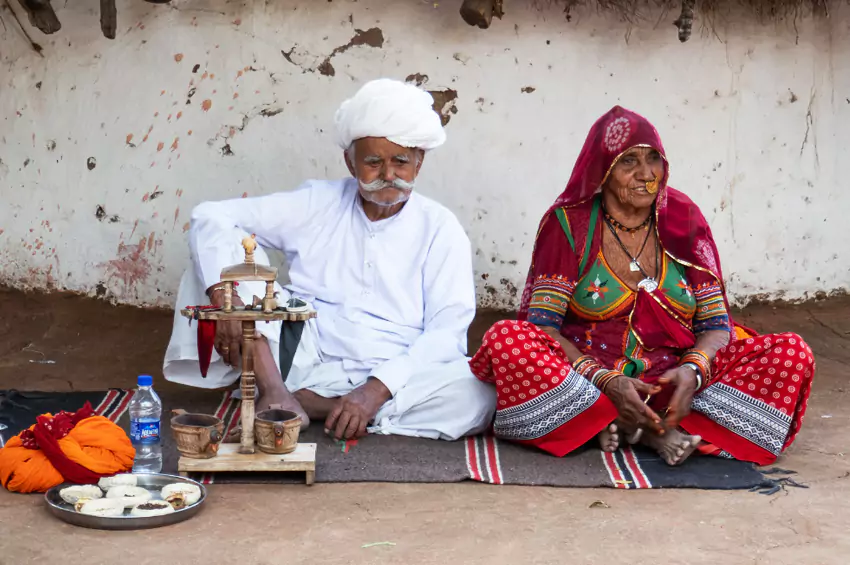
Upon reaching a Bishnoi household in the village, I was warmly greeted by the family head. Their hospitality was heartening, the traditional welcome making me feel right at home. Over conversations, I learned that during the monsoon, the Bishnois predominantly dwell in farmhouses, reflecting their deep reliance on agriculture. Later, I understood that the Bishnoi community mainly resides in these farmhouses during the monsoon season, as their primary livelihood is agriculture. In a region like Rajasthan, where water scarcity is a pressing concern, the Bishnois depend heavily on rainwater for their farming needs. This practice speaks to their adaptability and emphasizes their profound connection with nature and the earth’s rhythms.
The Bishnoi movement: Echoes of sacrifice in the Thar
I walked deeper into Guda Bishnoi Village, and the sight of a board titled “Bishnoi Movement” momentarily paused my steps. I had heard of this movement. Several centuries ago, this region witnessed an event that would become a beacon for environmentalists worldwide. The local king of Jodhpur, needing wood for constructing his palace, dispatched his men to cut down the revered Khejri trees in Khejarli village. For the Bishnois, the Khejri wasn’t merely a tree—it was a lifeline, a sacred symbol that sustained them amidst the unforgiving desert landscapes. When the king’s men arrived, it wasn’t long before Amrita Devi, a Bishnoi woman, realized their intent. Refusing to let the trees be harmed, she hugged one, making herself a shield against the axes. Her act of bravery and love for nature inspired others in her community.
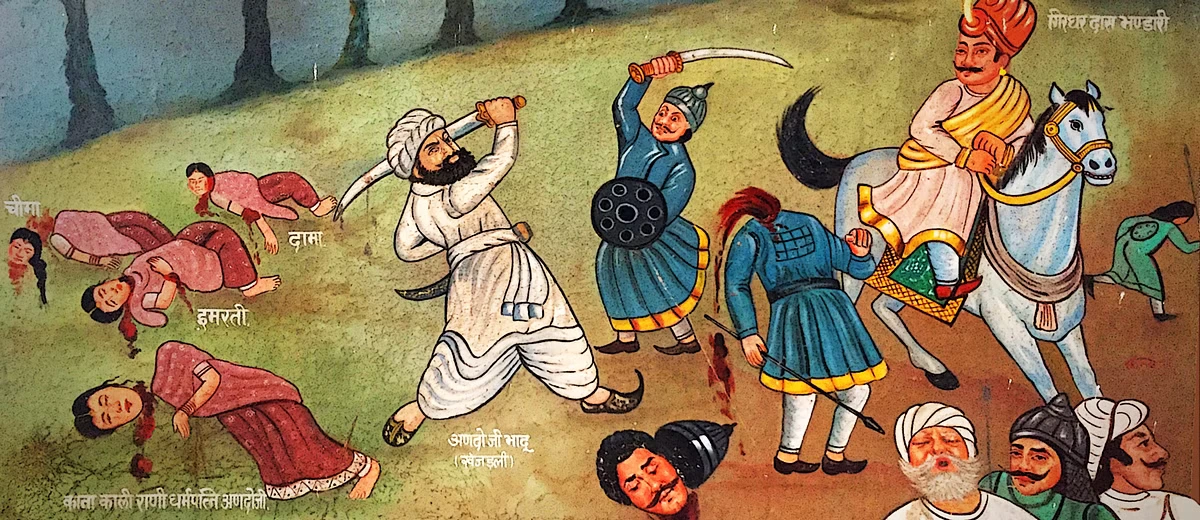
In a heart-wrenching turn of events, 363 Bishnoi men, women, and children laid down their lives, hugging the trees and protecting them with their very beings. Upon hearing this tragic loss of life for the sake of trees, the king issued a royal decree prohibiting the cutting of trees and hunting of animals in Bishnoi-dominated areas. Being in the village, feeling the whispers of the breeze, and looking at the trees ancestors had fought for, I felt a deep connection to their legacy. The Bishnoi Movement wasn’t just a historical event; it was a testament to a community’s unwavering love for nature, a deep love they were willing to give up their lives to protect it.
Threads of tradition – Beyond fabric and folds
The village head, sensing my keen interest in their culture, assigned a knowledgeable local to guide me through my exploration. As we meandered through the village pathways, a particular sight caught my eye: groups of villagers adorned in distinctive dresses, each piece telling its own story.
Curiosity piqued, I turned to my guide, pointing towards the villagers, “Their attire seems unique, each with its significance, doesn’t it?”
The guide nodded, a hint of pride evident in his eyes. “Indeed. Our clothing isn’t just about fashion; it reflects our beliefs, values, and deep respect for nature. You see, our community has specific guidelines even for our attire. For starters, we avoid blue, for its dye harms many shrubs.” He continued, explaining in depth. “The Bishnoi men traditionally wear a white shirt, dhoti, and a turban. These symbolize purity and shield us from the harsh desert climate. Their headgear, known as ‘potiya,’ is an ever-present accessory, signifying their identity. And you might notice some of our men flaunting ‘murki’ in their ears, showcasing our fondness for jewelry.”
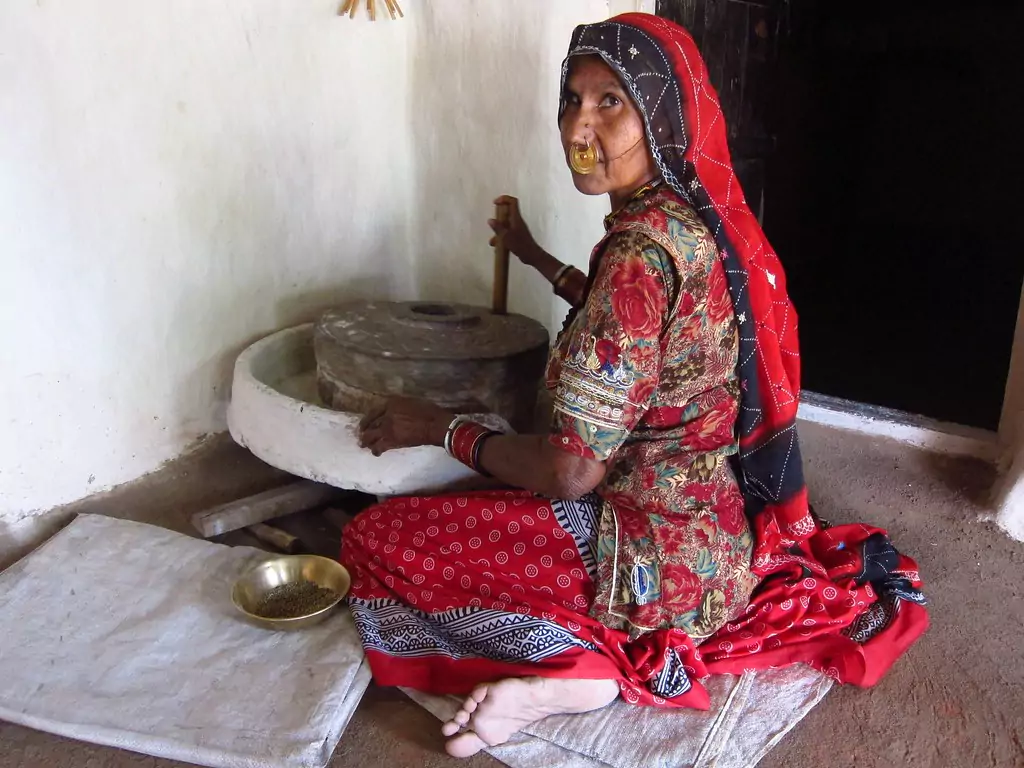
Drawing attention to the women, he elaborated, “Our women’s attire is a vibrant tapestry of customs. Unmarried girls wear the ‘puthia,’ ‘pada,’ and ‘odhna,’ while married women don the kanchli, kurti, and dhabla or ghaghra. Each garment is meticulously crafted, especially the dresses made for weddings, displaying intricate designs in mashru or chhint fabric. Odhnis, too, have variants, from the ‘pir ki chunri’ to the ‘kajli odhni,’ each with its own story.” I listened, enraptured by the depth of meaning behind each piece of clothing. It wasn’t just fabric but a testament to the Bishnoi’s legacy, their bond with nature, and their unwavering commitment to their traditions.
Harmony with nature: The Bishnoi ethos
My guide navigated more, plunging into the heart of the Bishnoi Village; he began to share insights that portrayed the profound harmony this community maintained with their environment.
“Our philosophy of Jeev Raksha isn’t merely a teaching; it’s our way of life,” my guide noted. They indicated the revered Khejri trees, “These trees are sacred. We adapt our ways and means around them, ensuring they remain unharmed, regardless of the challenges they might present.” The fields we passed were dotted with wild foliage. He pointed out that many farmers purposefully reserved portions of their areas for animals like blue bulls and cattle. “Our connection to nature goes beyond reverence,” they said with evident pride, “We stand as active protectors against any threats.”
I learned about an altercation that had taken place in the village, where Bishnoi men had confronted outsiders trying to hunt deer. The incident had escalated, leaving lasting scars in the community and reinforcing their reputation as fierce protectors of their environment. Their dedication wasn’t just an individual endeavor. My guide spoke of the community’s collective efforts, highlighting an organization that actively counters environmental violations. Born from the aftermath of a notorious poaching incident, this group had been at the forefront, combating everything from deforestation to poaching.
Furthermore, the Bishnois’ support for animal rescue efforts was unparalleled. At a local rescue center, I was told that most of the injured animals were saved by members of the Bishnoi community, who often took personal initiatives to ensure their safe care. Yet, the most touching sentiment was shared as we paused near a communal space.
Hand block printing: An artistic encounter in the village
The Bishnoi Village had proven to be a revelation in more ways than one. As I meandered through Kankani Village, I noticed hints of colorful fabrics drying under the afternoon sun, their vibrant patterns against the rustic backdrop. A gentle breeze carried whispers of a conversation, and I followed the sound, intrigued.
As I turned a corner, an elderly village woman, her face weathered with time yet eyes gleaming with youthful enthusiasm, noticed my interest in the fabrics. “Ah, the magic of hand block printing,” she said, gesturing towards the swathes of patterned cloth. “You must visit Master Vishnu’s home. He’s a Chhipa, one of our finest craftsmen. Thankful for the lead, I traced my way through narrow alleys until I reached a humble abode with a courtyard awash in a medley of fabrics – a visual symphony of patterns and colors. An older man, presumably Master Vishnu, was engrossed in his work.
The rhythmic craft: An encounter in Bishnoi village
I stepped in, and drawn by the rhythmic thudding of a block on fabric, Master Vishnu, a seasoned artisan with an aura of wisdom around him, beckoned me closer. Ah, another traveler drawn by the allure of our craft, he said, his voice rich with warmth and pride.
Seizing the opportunity, I shared, “I’ve read about block printing but never had the privilege to witness it up close.”
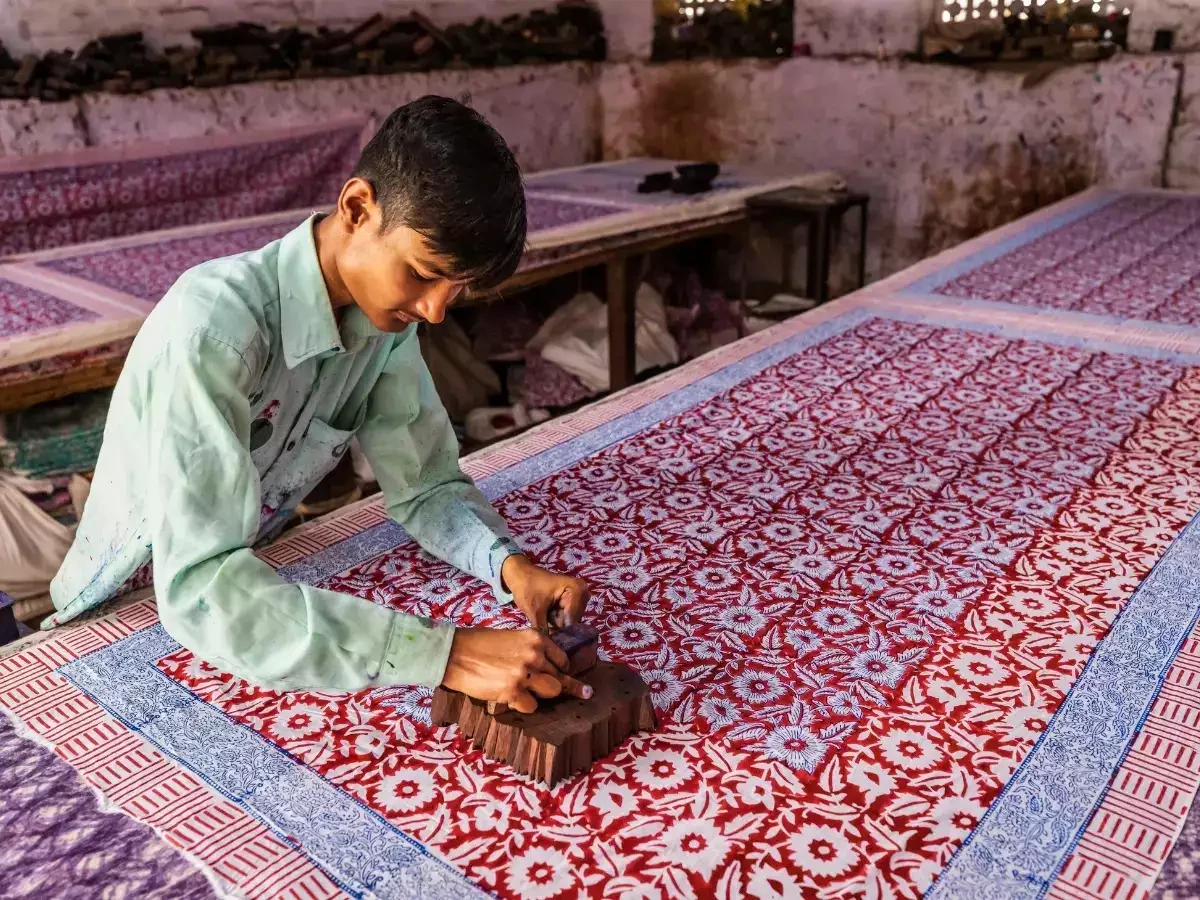
Master Vishnu, sensing my genuine intrigue, began, For those unfamiliar, block printing is an art that uses carved pieces of wood, or sometimes other wooden blocks, adorned with intricate patterns. These patterns are the soulful reflections of a craftsman’s creativity. He showed me a delicately carved block, its design mirroring the splendors of nature. “These designs,” he continued, “are first carved onto the wood. Once ready, the block is immersed in dyes, soaking up the vibrant colors.” With an expert’s precision, he pressed the block onto a stretched fabric, and the design came alive in an instant.
Stamps of Time – The Enduring Craft of Chhipa Block Printing
These patterns, he explained, “are meticulously stamped in an organized manner, creating a tapestry of spellbinding symmetry on the fabric. Our community, the Chhipas, have been the master craftsmen behind this magic for generations.”
Taking a moment to immerse another block in a new color, he mentioned, “In the past, our ancestors primarily used these techniques for book covers.” The world has evolved, and now, our art graces fabrics, telling tales of heritage and history.” Pointing at a distant wall adorned with various blocks, he shared, “Block printing, believed to have its origin right here in India, has now touched corners far and wide. Its beauty resonates globally.”
His hands worked tirelessly, but his voice never wavered in enthusiasm. If you’re truly fascinated, I can offer you one of these carved blocks. And if you’re lucky, he said with a mischievous glint, “You might just be able to take some of our fabric home.” As I left Master Vishnu’s abode, a piece of fabric wrapped carefully under my arm and a carved block in hand. I was not just carrying souvenirs, I bore tales of a community’s dedication, the artistry of generations, and the heartbeat of that village. Do you want to experience the hand-block printing lessons from the masters in the town? Just download the Savaari car rental app and book your trip now.
Things to do in Bishnoi village
Having spent some enriching days in the heart of Bishnoi Village, I’ve embraced its charm, traditions of its community. If you’re planning to venture into this cultural haven, here’s a curated itinerary based on my personal experiences –

- Bishnoi Village Safari – Opt for the village safari, an immersive experience that offers a glimpse into the villagers’ daily lives. Whether you choose a jeep or a camel-back journey, the sights and sounds you encounter will be unforgettable.
- Guda village and lakeside – Stroll around Guda Lake and the neighboring ponds. You might spot blackbucks, blue bulls, or even a desert fox if you’re lucky. Bird enthusiasts will find the area particularly enchanting, with local and migratory birds dotting the sky. Opting for a local guide will enrich your experience as they bring tales and insights about the area.
- Meet the Bishnoi community – Delve deep into the heart of the Bishnoi community’s ethos. Their unwavering dedication to Mother Earth, devotion to Lord Vishnu, and vegetarian practices provide a refreshing perspective on harmonious living.
- Hand block printing in Kankani village – Witness the traditional art of block printing. Experience the captivating symphony of patterns, colors, and designs firsthand. If you’re keen on souvenirs, purchase a carved block or some exquisitely printed fabric.
- Experience authentic Bishnoi hospitality – As you wander, expect locals to invite you into their homes. People maintain the small hamlets, known as ‘Dhani,’ with care and warmth. Take a moment to appreciate their unique architecture. Especially the mud floors plastered with cow dung, reflecting their commitment to cleanliness and nature. You can experience all these activities just by booking a Savaari.
Explore nearby villages
Salawas village – This village is 19 km aways from Bishnois village. Home to skilled weavers, you can witness the intricate process of carpet making and even buy directly from the artisans.
Singhasni village – A haven for pottery lovers, explore the miniature and intricate works that are a testament to the village’s rich heritage. You can reach this village by traveling 33 km.
Gudha village– A delight for wildlife enthusiasts, you might chance upon gazelles, wild rabbits, and even the elusive Demoiselle crane.
The Bishnoi Chronicles: Guardians of Nature Across Generations
The amber hues of twilight painted the Bishnoi Village, and I found myself amidst a gathering around a campfire. The warm glow of flames set the stage for an evening of storytelling. An elder, his hair streaked with silver and eyes reflecting years of wisdom, began weaving tales that spanned centuries.
He spoke of the tales of our ancestors, especially the Khejarli massacre, and how it found resonance in the distant hills of Uttarakhand in the 1970s. The Chipko Movement, he mentioned, saw villagers, primarily women, embracing trees to prevent their felling, echoing the spirit and sacrifice of the Bishnoi community. “Our tales of valor, sacrifice, and unwavering commitment to nature sparked similar sentiments in other parts of India,” the elder continued. He told of various eco-conscious groups that drew inspiration from the Bishnoi ethos, forming local movements and adopting practices harmonizing with the environment.
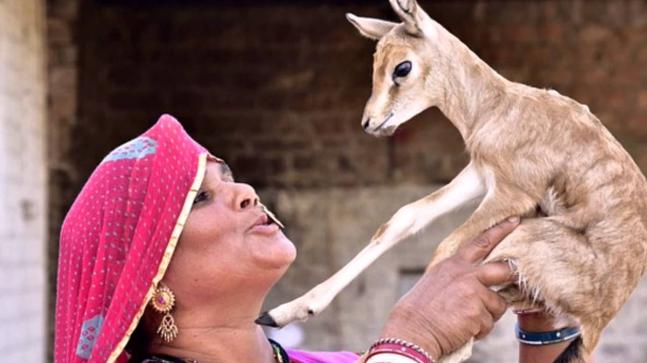
The elder then shifted his focus to the present day. “Our community continues its role as guardians of the environment,” he shared. Tales of Bishnoi individuals running animal rescue shelters, actively rehabilitating injured animals and patrolling forests to prevent poaching painted a vivid picture of their dedication. “Our homes and agricultural practices emphasize sustainability. We’ve embraced water harvesting techniques, organic farming, and communal efforts in reforestation and conservation, ensuring our principles adapt to modern challenges,” he elaborated.
The night deepened, and the tales left an indelible mark as the campfire’s embers faded. The Bishnoi legacy wasn’t just a tale of the past; it was an ongoing journey, alive in every heartbeat of the community.
The last horizon: Bidding farewell to Bishnois
The soft coos of pigeons and the distant murmur of villagers starting their day punctuated the early morning stillness of the Bishnoi Village. It was a stark contrast to the vibrancy and energy of the previous evening, a gentle reminder that every story, no matter how captivating, has its closing chapter.
With a heavy heart, I strolled through the village for one last time. First, I tuned into the birds chirping, then I was drawn to the distant laughter of children playing. I felt the warmth of the villagers who had now become like family to me.
Every step echoed the tales I had heard, the traditions I had witnessed, and the unwavering commitment to nature I had felt here. Each face I passed held a story, a memory, a testament to the legacy of the Bishnoi community. They were the true guardians of the land, and their spirit had now found a place in my heart.
As I reached the outskirts, my Savaari ride awaited, ready to transport me to Jodhpur Airport. The journey back was quiet, filled with introspection and gratitude for the experiences that had enriched my soul. Boarding my flight back to Mumbai. I observed a stark contrast between the tranquil Bishnoi Village and the busyhustle of Mumbai’s metropolis.
As the plane soared above the clouds, I carried with me memories, a renewed sense of purpose, and an undying respect for communities like the Bishnois, who continue to live in harmony with Mother Earth. The city lights of Mumbai came into view, signaling the end of my journey. I realized that every trip we take leaves an imprint on our souls. But this journey to the heart of the Bishnoi Village had transformed me in ways I had never imagined.
Useful travel information
- IHHA holds its 10th annual convention at Neemrana, which focuses on promoting heritage tourism
- Jaipur is the top cultural and heritage destination, reveals a World Tourism Day Report
Last Updated on December 14, 2023 by Arathy Subhash Marath




